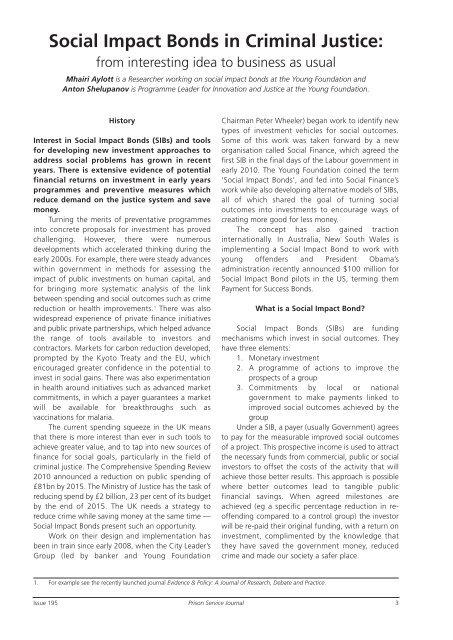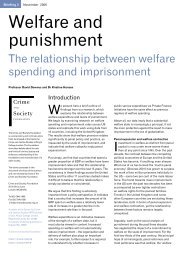Focus on Disability
Focus on Disability
Focus on Disability
Create successful ePaper yourself
Turn your PDF publications into a flip-book with our unique Google optimized e-Paper software.
Social Impact B<strong>on</strong>ds in Criminal Justice:<br />
from interesting idea to business as usual<br />
Mhairi Aylott is a Researcher working <strong>on</strong> social impact b<strong>on</strong>ds at the Young Foundati<strong>on</strong> and<br />
Ant<strong>on</strong> Shelupanov is Programme Leader for Innovati<strong>on</strong> and Justice at the Young Foundati<strong>on</strong>.<br />
History<br />
Interest in Social Impact B<strong>on</strong>ds (SIBs) and tools<br />
for developing new investment approaches to<br />
address social problems has grown in recent<br />
years. There is extensive evidence of potential<br />
financial returns <strong>on</strong> investment in early years<br />
programmes and preventive measures which<br />
reduce demand <strong>on</strong> the justice system and save<br />
m<strong>on</strong>ey.<br />
Turning the merits of preventative programmes<br />
into c<strong>on</strong>crete proposals for investment has proved<br />
challenging. However, there were numerous<br />
developments which accelerated thinking during the<br />
early 2000s. For example, there were steady advances<br />
within government in methods for assessing the<br />
impact of public investments <strong>on</strong> human capital, and<br />
for bringing more systematic analysis of the link<br />
between spending and social outcomes such as crime<br />
reducti<strong>on</strong> or health improvements. 1 There was also<br />
widespread experience of private finance initiatives<br />
and public private partnerships, which helped advance<br />
the range of tools available to investors and<br />
c<strong>on</strong>tractors. Markets for carb<strong>on</strong> reducti<strong>on</strong> developed,<br />
prompted by the Kyoto Treaty and the EU, which<br />
encouraged greater c<strong>on</strong>fidence in the potential to<br />
invest in social gains. There was also experimentati<strong>on</strong><br />
in health around initiatives such as advanced market<br />
commitments, in which a payer guarantees a market<br />
will be available for breakthroughs such as<br />
vaccinati<strong>on</strong>s for malaria.<br />
The current spending squeeze in the UK means<br />
that there is more interest than ever in such tools to<br />
achieve greater value, and to tap into new sources of<br />
finance for social goals, particularly in the field of<br />
criminal justice. The Comprehensive Spending Review<br />
2010 announced a reducti<strong>on</strong> <strong>on</strong> public spending of<br />
£81bn by 2015. The Ministry of Justice has the task of<br />
reducing spend by £2 billi<strong>on</strong>, 23 per cent of its budget<br />
by the end of 2015. The UK needs a strategy to<br />
reduce crime while saving m<strong>on</strong>ey at the same time —<br />
Social Impact B<strong>on</strong>ds present such an opportunity.<br />
Work <strong>on</strong> their design and implementati<strong>on</strong> has<br />
been in train since early 2008, when the City Leader’s<br />
Group (led by banker and Young Foundati<strong>on</strong><br />
Chairman Peter Wheeler) began work to identify new<br />
types of investment vehicles for social outcomes.<br />
Some of this work was taken forward by a new<br />
organisati<strong>on</strong> called Social Finance, which agreed the<br />
first SIB in the final days of the Labour government in<br />
early 2010. The Young Foundati<strong>on</strong> coined the term<br />
‘Social Impact B<strong>on</strong>ds’, and fed into Social Finance’s<br />
work while also developing alternative models of SIBs,<br />
all of which shared the goal of turning social<br />
outcomes into investments to encourage ways of<br />
creating more good for less m<strong>on</strong>ey.<br />
The c<strong>on</strong>cept has also gained tracti<strong>on</strong><br />
internati<strong>on</strong>ally. In Australia, New South Wales is<br />
implementing a Social Impact B<strong>on</strong>d to work with<br />
young offenders and President Obama’s<br />
administrati<strong>on</strong> recently announced $100 milli<strong>on</strong> for<br />
Social Impact B<strong>on</strong>d pilots in the US, terming them<br />
Payment for Success B<strong>on</strong>ds.<br />
What is a Social Impact B<strong>on</strong>d?<br />
Social Impact B<strong>on</strong>ds (SIBs) are funding<br />
mechanisms which invest in social outcomes. They<br />
have three elements:<br />
1. M<strong>on</strong>etary investment<br />
2. A programme of acti<strong>on</strong>s to improve the<br />
prospects of a group<br />
3. Commitments by local or nati<strong>on</strong>al<br />
government to make payments linked to<br />
improved social outcomes achieved by the<br />
group<br />
Under a SIB, a payer (usually Government) agrees<br />
to pay for the measurable improved social outcomes<br />
of a project. This prospective income is used to attract<br />
the necessary funds from commercial, public or social<br />
investors to offset the costs of the activity that will<br />
achieve those better results. This approach is possible<br />
where better outcomes lead to tangible public<br />
financial savings. When agreed milest<strong>on</strong>es are<br />
achieved (eg a specific percentage reducti<strong>on</strong> in reoffending<br />
compared to a c<strong>on</strong>trol group) the investor<br />
will be re-paid their original funding, with a return <strong>on</strong><br />
investment, complimented by the knowledge that<br />
they have saved the government m<strong>on</strong>ey, reduced<br />
crime and made our society a safer place.<br />
1. For example see the recently launched journal Evidence & Policy: A Journal of Research, Debate and Practice.<br />
Issue 195 Pris<strong>on</strong> Service Journal<br />
3











